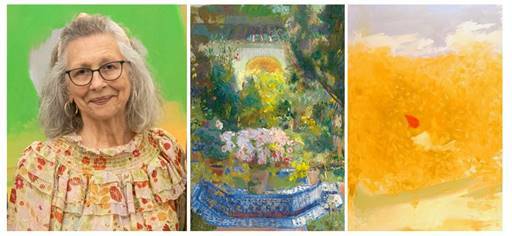
In two upcoming noontime talks — on September 8 and 15 — Alicia G. Longwell, Ph.D., Lewis B. and Dorothy Cullman Chief Curator at the Parrish Art Museum, will share insights and scholarship on Joaquín Sorolla (Spanish, 1863−1923) and Esteban Vicente (American, born Spain, 1903–2001). The two preeminent Spanish artists were deeply inspired by the light and color emanating from their gardens during their later creative periods and their work is currently on view in the exhibition “In the Light of the Garden.” Organized by Longwell, the show features paintings by Sorolla dating from 1916 to 1919, and paintings, works on paper and small sculptures made by Vicente between 1985 and 2000.
Longwell focuses on Sorolla in her noon talk on Thursday, September, and on Vicente on Thursday, September 15, also at noon.
In 1905, the internationally celebrated artist Joaquín Sorolla chose for his new home a plot of land far from central Madrid, on what is now Calle General Martínez Campos, where his closest neighbors were wandering goat herds. Renowned not only for history painting and portraits but also seaside vistas in the Impressionist mode, Sorolla wanted above all to unite his three passions — for family, painting and being outdoors in nature. He designed the house and adjoining studio in meticulous detail, creating three separate gardens and a courtyard that would integrate seamlessly with the architectural elements and unite the site into a functional and harmonious whole.
By 1911 his wife Clotilde and children were living there, but it would take another five years to complete the gardens. Sorolla conceived the garden at his Madrid home as a reflection of his creativity and a work of art in itself. In his late paintings on view in the exhibition, Sorolla is no longer concerned with describing the individual elements that he has so carefully orchestrated. He is capturing in paint the color, light, and atmosphere of his beloved gardens—an approach that has become his enduring legacy.
Esteban Vicente was born in the Spanish countryside village of Turégano. Following periods of work and study in Paris and Barcelona in the 1920s and 1930s, Vicente immigrated to New York and in 1940, became an American citizen. He soon formed close friendships with many New York School painters including Willem de Kooning, Jackson Pollock, and Mark Rothko. Although considered an Abstract Expressionist, the work of his last decades became looser, more diffuse, and deeply grounded in nature.
In 1964 a move to Bridgehampton allowed Vicente an extended period out of the city. He soon began a garden and in lieu of formal planning, he took his cue from the surrounding meadow to create a naturalistic setting marked by large swaths of native plants massed to spectacular effect. Vicente set up a studio in an 18th-century barn at his farmhouse where he painted his garden’s changing field of color. Favorite flowers like poppies, black-eyed Susans, Queen Anne’s lace, sunflowers, and day lilies played against the green of the meadow, furnishing continual inspiration for his late paintings
“In the Light of the Garden” is presented in collaboration with the Museo de Arte Contemporáneo Esteban Vicente, Segovia, Ana Doldán de Cáceres, Director and Museo Sorolla, Madrid. The exhibition is accompanied by the catalogue “Joaquín Sorolla and Esteban Vicente: In the Light of the Garden,” featuring essays by Ana Doldán de Cáceres and Eduardo Bardo Gómez.
Guests to both talks are invited to preorder lunch through the Café at the Parrish to enjoy during the talk. Outside food is not permitted. Attendees may enjoy a special discount in the Parrish Café. Tickets for each talk are $12 ($9 seniors, free for Parrish members, students and children). The Parrish Art Museum is at 279 Montauk Highway in Water Mill. For more information, visit parrishart.org.